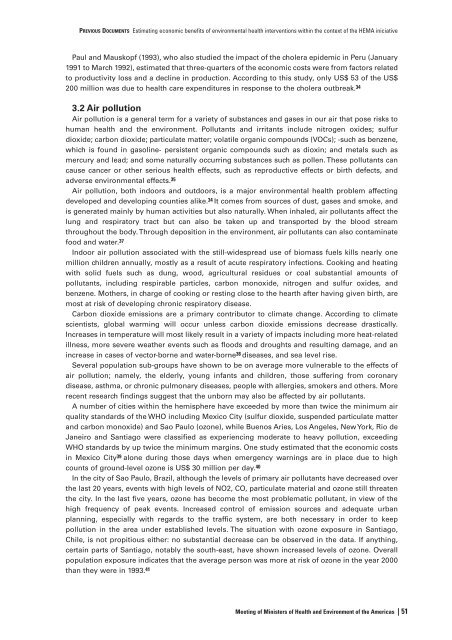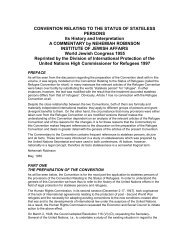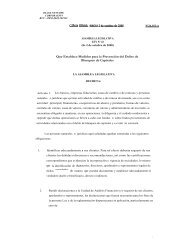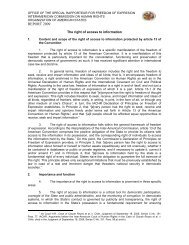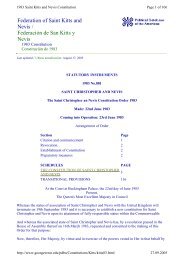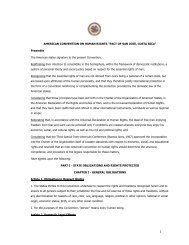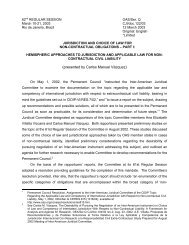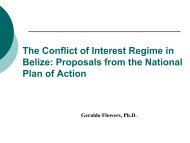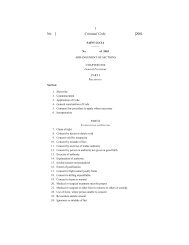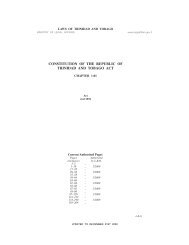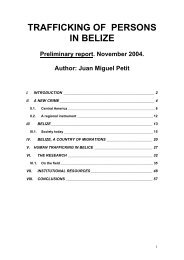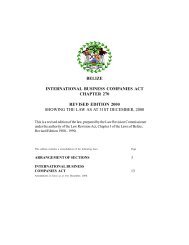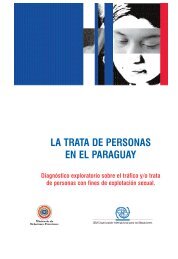(HEMA) Initiative. - OAS
(HEMA) Initiative. - OAS
(HEMA) Initiative. - OAS
You also want an ePaper? Increase the reach of your titles
YUMPU automatically turns print PDFs into web optimized ePapers that Google loves.
PREVIOUS DOCUMENTS Estimating economic benefits of environmental health interventions within the context of the <strong>HEMA</strong> iniciative<br />
Paul and Mauskopf (1993), who also studied the impact of the cholera epidemic in Peru (January<br />
1991 to March 1992), estimated that three-quarters of the economic costs were from factors related<br />
to productivity loss and a decline in production. According to this study, only US$ 53 of the US$<br />
200 million was due to health care expenditures in response to the cholera outbreak. 34<br />
3.2 Air pollution<br />
Air pollution is a general term for a variety of substances and gases in our air that pose risks to<br />
human health and the environment. Pollutants and irritants include nitrogen oxides; sulfur<br />
dioxide; carbon dioxide; particulate matter; volatile organic compounds (VOCs); -such as benzene,<br />
which is found in gasoline- persistent organic compounds such as dioxin; and metals such as<br />
mercury and lead; and some naturally occurring substances such as pollen. These pollutants can<br />
cause cancer or other serious health effects, such as reproductive effects or birth defects, and<br />
adverse environmental effects. 35<br />
Air pollution, both indoors and outdoors, is a major environmental health problem affecting<br />
developed and developing counties alike. 34 It comes from sources of dust, gases and smoke, and<br />
is generated mainly by human activities but also naturally. When inhaled, air pollutants affect the<br />
lung and respiratory tract but can also be taken up and transported by the blood stream<br />
throughout the body. Through deposition in the environment, air pollutants can also contaminate<br />
food and water. 37<br />
Indoor air pollution associated with the still-widespread use of biomass fuels kills nearly one<br />
million children annually, mostly as a result of acute respiratory infections. Cooking and heating<br />
with solid fuels such as dung, wood, agricultural residues or coal substantial amounts of<br />
pollutants, including respirable particles, carbon monoxide, nitrogen and sulfur oxides, and<br />
benzene. Mothers, in charge of cooking or resting close to the hearth after having given birth, are<br />
most at risk of developing chronic respiratory disease.<br />
Carbon dioxide emissions are a primary contributor to climate change. According to climate<br />
scientists, global warming will occur unless carbon dioxide emissions decrease drastically.<br />
Increases in temperature will most likely result in a variety of impacts including more heat-related<br />
illness, more severe weather events such as floods and droughts and resulting damage, and an<br />
increase in cases of vector-borne and water-borne 38 diseases, and sea level rise.<br />
Several population sub-groups have shown to be on average more vulnerable to the effects of<br />
air pollution; namely, the elderly, young infants and children, those suffering from coronary<br />
disease, asthma, or chronic pulmonary diseases, people with allergies, smokers and others. More<br />
recent research findings suggest that the unborn may also be affected by air pollutants.<br />
A number of cities within the hemisphere have exceeded by more than twice the minimum air<br />
quality standards of the WHO including Mexico City (sulfur dioxide, suspended particulate matter<br />
and carbon monoxide) and Sao Paulo (ozone), while Buenos Aries, Los Angeles, New York, Rio de<br />
Janeiro and Santiago were classified as experiencing moderate to heavy pollution, exceeding<br />
WHO standards by up twice the minimum margins. One study estimated that the economic costs<br />
in Mexico City 39 alone during those days when emergency warnings are in place due to high<br />
counts of ground-level ozone is US$ 30 million per day. 40<br />
In the city of Sao Paulo, Brazil, although the levels of primary air pollutants have decreased over<br />
the last 20 years, events with high levels of NO2, CO, particulate material and ozone still threaten<br />
the city. In the last five years, ozone has become the most problematic pollutant, in view of the<br />
high frequency of peak events. Increased control of emission sources and adequate urban<br />
planning, especially with regards to the traffic system, are both necessary in order to keep<br />
pollution in the area under established levels. The situation with ozone exposure in Santiago,<br />
Chile, is not propitious either: no substantial decrease can be observed in the data. If anything,<br />
certain parts of Santiago, notably the south-east, have shown increased levels of ozone. Overall<br />
population exposure indicates that the average person was more at risk of ozone in the year 2000<br />
than they were in 1993. 41 Meeting of Ministers of Health and Environment of the Americas |<br />
51


